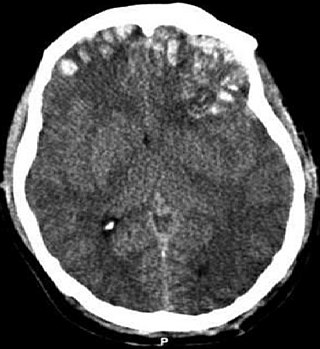
A repetitive strain injury (RSI) is an injury to part of the musculoskeletal or nervous system caused by repetitive use, vibrations, compression or long periods in a fixed position. Other common names include repetitive stress injury, repetitive stress disorders, cumulative trauma disorders (CTDs), and overuse syndrome.

Whiplash is a non-clinical term describing a range of injuries to the neck caused by or related to a sudden distortion of the neck associated with extension, although the exact injury mechanisms remain unknown. The term "whiplash" is a colloquialism. "Cervical acceleration–deceleration" (CAD) describes the mechanism of the injury, while the term "whiplash associated disorders" (WAD) describes the subsequent injuries and symptoms.

Major trauma is any injury that has the potential to cause prolonged disability or death. There are many causes of major trauma, blunt and penetrating, including falls, motor vehicle collisions, stabbing wounds, and gunshot wounds. Depending on the severity of injury, quickness of management, and transportation to an appropriate medical facility may be necessary to prevent loss of life or limb. The initial assessment is critical, and involves a physical evaluation and also may include the use of imaging tools to determine the types of injuries accurately and to formulate a course of treatment.

A traumatic brain injury (TBI), also known as an intracranial injury, is an injury to the brain caused by an external force. TBI can be classified based on severity ranging from mild traumatic brain injury (mTBI/concussion) to severe traumatic brain injury. TBI can also be characterized based on mechanism or other features. Head injury is a broader category that may involve damage to other structures such as the scalp and skull. TBI can result in physical, cognitive, social, emotional and behavioral symptoms, and outcomes can range from complete recovery to permanent disability or death.

The National Traffic and Motor Vehicle Safety Act was enacted in the United States in 1966 to empower the federal government to set and administer new safety standards for motor vehicles and road traffic safety. The Act was the first mandatory federal safety standards for motor vehicles. The Act created the National Highway Safety Bureau. The Act was one of a number of initiatives by the government in response to increasing number of cars and associated fatalities and injuries on the road following a period when the number of people killed on the road had increased 6-fold and the number of vehicles was up 11-fold since 1925. The reduction of the rate of death attributable to motor-vehicle crashes in the United States represents the successful public health response to a great technologic advance of the 20th century—the motorization of the United States.

A needlestick injury is the penetration of the skin by a hypodermic needle or other sharp object that has been in contact with blood, tissue or other body fluids before the exposure. Even though the acute physiological effects of a needlestick injury are generally negligible, these injuries can lead to transmission of blood-borne diseases, placing those exposed at increased risk of infection from disease-causing pathogens, such as the hepatitis B virus (HBV), hepatitis C virus (HCV), and human immunodeficiency virus (HIV). Among healthcare workers and laboratory personnel worldwide, more than 25 blood-borne virus infections have been reported to have been caused by needlestick injuries. In addition to needlestick injuries, transmission of these viruses can also occur as a result of contamination of the mucous membranes, such as those of the eyes, with blood or body fluids, but needlestick injuries make up more than 80% of all percutaneous exposure incidents in the United States. Various other occupations are also at increased risk of needlestick injury, including law enforcement, laborers, tattoo artists, food preparers, and agricultural workers.
A waiting period is the period of time between when an action is requested or mandated and when it occurs.
Tooth loss is a process in which one or more teeth come loose and fall out. Tooth loss is normal for deciduous teeth, when they are replaced by a person's adult teeth. Otherwise, losing teeth is undesirable and is the result of injury or disease, such as dental avulsion, tooth decay, and gum disease. The condition of being toothless or missing one or more teeth is called edentulism. Tooth loss has been shown to causally reduce overall health and wellbeing as it increases the probability of depression.
Injury prevention is an effort to prevent or reduce the severity of bodily injuries caused by external mechanisms, such as accidents, before they occur. Injury prevention is a component of safety and public health, and its goal is to improve the health of the population by preventing injuries and hence improving quality of life. Among laypersons, the term "accidental injury" is often used. However, "accidental" implies the causes of injuries are random in nature. Researchers prefer the term "unintentional injury" to refer to injuries that are nonvolitional but often preventable. Data from the U.S. Centers for Disease Control show that unintentional injuries are a significant public health concern: they are by far the leading cause of death from ages 1 through 44. During these years, unintentional injuries account for more deaths than the next three leading causes of death combined. Unintentional injuries also account for the top ten sources of nonfatal emergency room visits for persons up to age 9 and nine of the top ten sources of nonfatal emergency room visits for persons over the age of 9.

Intraventricular hemorrhage (IVH), also known as intraventricular bleeding, is a bleeding into the brain's ventricular system, where the cerebrospinal fluid is produced and circulates through towards the subarachnoid space. It can result from physical trauma or from hemorrhagic stroke.
Molecular epidemiology is a branch of epidemiology and medical science that focuses on the contribution of potential genetic and environmental risk factors, identified at the molecular level, to the etiology, distribution and prevention of disease within families and across populations. This field has emerged from the integration of molecular biology into traditional epidemiological research. Molecular epidemiology improves our understanding of the pathogenesis of disease by identifying specific pathways, molecules and genes that influence the risk of developing disease. More broadly, it seeks to establish understanding of how the interactions between genetic traits and environmental exposures result in disease.
In medicine, an external cause is a reason for the existence of a medical condition which can be associated with a specific object or acute process that was caused by something outside the body. Such causes are classified as "E codes" in ICD 9.
The U.S. Centers for Disease Control and Prevention's National Center for Injury Prevention and Control's mission is to provide leadership in preventing and controlling injuries, i.e., reducing the incidence, severity, and adverse outcomes of injury, the leading cause of death for those aged 1 – 44. A 1985 National Research Council report entitled Injury in America recommended that United States Congress establish a new program at the CDC to address the problem of injury. Initially the program was supported with funds from the United States Department of Transportation. In 1990 Congress passed the Injury Control Act which authorized the program within the CDC, and in 1992, the CDC formally established the Center. The Center has three branches: the Division of Acute Care, Rehabilitation Research, and Disability Prevention; the Division of Unintentional Injury Prevention; and the Division of Violence Prevention.
A catastrophic injury is a severe injury to the spine, spinal cord, or brain. It may also include skull or spinal fractures. This is a subset of the definition for the legal term catastrophic injury, which is based on the definition used by the American Medical Association.

The Memorial Bridge, also known as the Kennebec Memorial Bridge, is a bridge in Augusta, Maine, that crosses the Kennebec River, joining the east and west sides of the city. It carries U.S. Route 201, U.S. Route 202, Route 11, and Route 100. The bridge is approximately 2,100 feet long and has two lanes for traffic and a barrier-protected sidewalk for pedestrians on each side of the roadway. It was built in 1949.

Limor Aharonson-Daniel is an Israeli emergency preparedness expert.
Jonathan P Shepherd CBE FRCS FFPH FRCPsych FMedSci FLSW is a Welsh surgeon, criminologist and professor at Cardiff University's Crime and Security Research Institute which he co-founded in 2015. He also founded the University's Violence Research Group. He has initiated UK public service reforms and other measures to strengthen the evidence foundations on which these services are based. These include new professional bodies for policing, probation and teaching; the UK What Works Centres and What Works Council; new university police research centres in England and Wales; and a new police research funding scheme.

Caroline Finch AO is an Australian sports injury epidemiologist and sports injury prevention researcher. Her research has been adopted and used to directly inform safety policy by Government Departments of Sport and Health, health promotion and injury prevention agencies, and peak sports bodies both within Australia and internationally. Her injury prevention research has been applied to falls in older people, road safety, workplace safety and injuries in children.
Olive Chifefe Kobusingye is a Ugandan consultant trauma surgeon, emergency surgeon, accident injury epidemiologist and academic, who serves as a Senior Research Fellow at both Makerere University School of Public Health and the Institute for Social and Health Sciences of the University of South Africa. She heads the Trauma, Injury, & Disability (TRIAD) Project at Makerere University School of Public Health, where she coordinates the TRIAD graduate courses.
Prophylactic surgery, is a form of surgery whose purpose is to minimize or prevent the risk of developing cancer in an organ or gland that has yet to develop cancer and is known to be at high risk of developing cancer. This form of preventive healthcare may include surgeries such as mastectomies, oophorectomies, colectomies and surgical corrections, such as the surgical correction of cryptorchidism or undescended testis. Another less common definition of prophylactic surgery also includes the prevention of other diseases, outcomes or even future appearance.